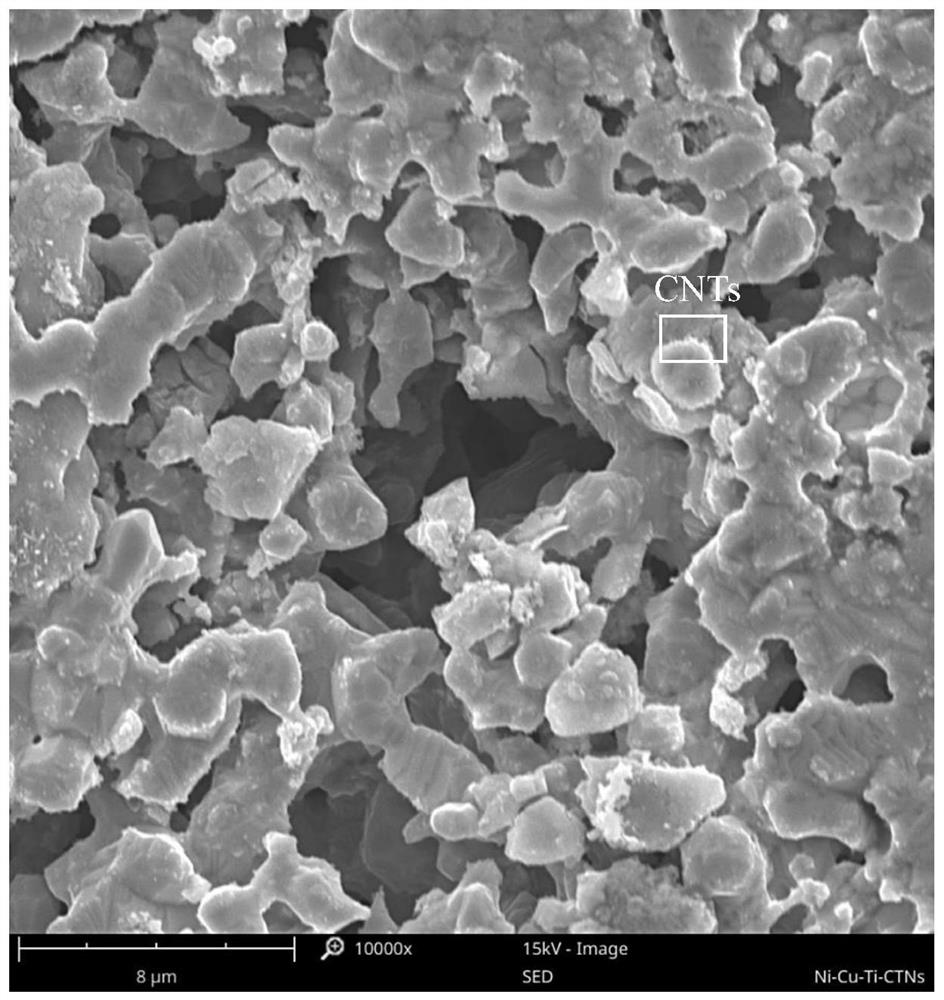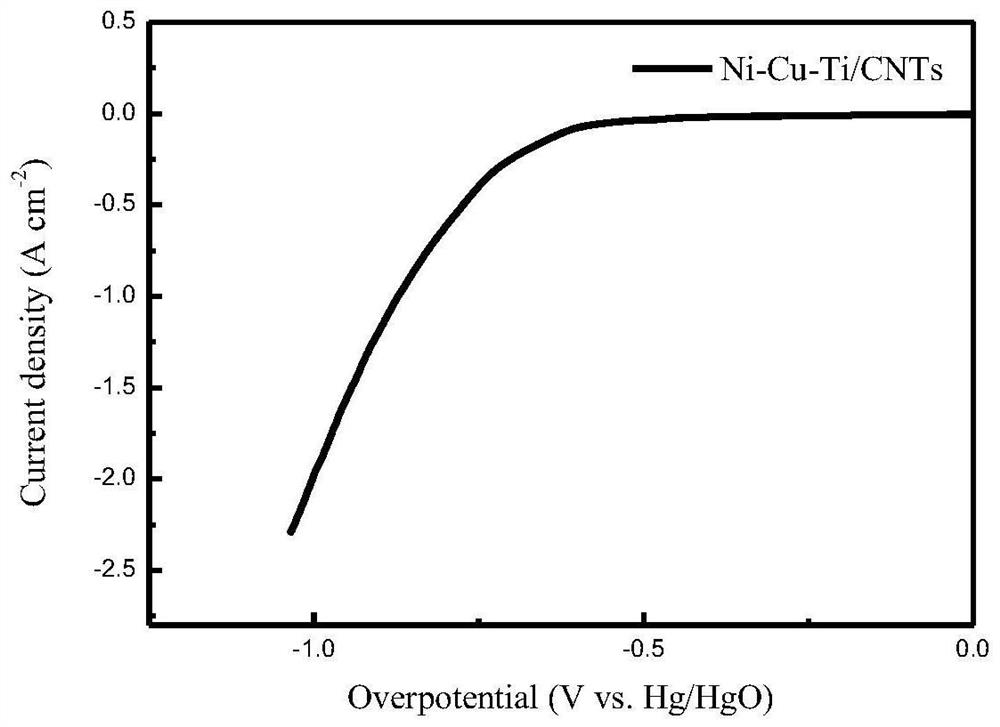A kind of ni-cu-ti/cnts porous composite material and preparation method thereof
A porous composite material, ni-cu-ti technology, applied in electrode coatings, energy input, electrolysis components, etc., can solve the problems of easy loss of hydrogen evolution activity, power-off gap, etc., to achieve rich porosity, extended service life, mechanical Excellent performance and corrosion resistance
- Summary
- Abstract
- Description
- Claims
- Application Information
AI Technical Summary
Problems solved by technology
Method used
Image
Examples
Embodiment 1
[0025] Three high-purity powders of Ni, Cu, Ti, and CNTs were weighed according to a certain mass ratio. The Ni powder content was 55%wt, and the powder particle size was 5μm; the Cu powder content was 35%wt, and the powder particle size was 5μm; Ti The powder content is 10%wt, the powder particle size is 5μm, and the CNTs content is 0.3%wt. It is a multi-walled carbon nanotube with a length of 1μm. The weighed CNTs were added to deionized water at a ratio of 0.1 g / L, and 68% of sodium dodecylbenzenesulfonate, 150% of Tween-20, and 150% of polystyrene were added relative to the mass of CNTs. Vinylpyrrolidone, the mixed solution was placed in an ultrasonic cleaner for ultrasonic dispersion for 30min. After ultrasonication, the weighed Ni, Cu, and Ti powders were added and stirred on a magnetic stirrer until the solution was separated into layers. After stirring, carry out vacuum filtration, place the separated powder in a vacuum drying box at 75 degrees for drying for 5 hours,...
Embodiment 2
[0029] Three high-purity powders of Ni, Cu, Ti, and carbon nanotubes were weighed according to a certain mass ratio, wherein the Ni powder content was 56%wt, the powder particle size was 4μm; the Cu powder content was 33%wt, and the powder particle size was 4μm ; Ti powder content of 11%wt, powder particle size of 4μm, CNTs content of 0.4%wt, is a multi-walled carbon nanotube with a length of 2μm. The weighed CNTs were added to deionized water at a ratio of 0.1 g / L, and 68% of sodium dodecylbenzenesulfonate, 150% of Tween-20, and 150% of polystyrene were added relative to the mass of CNTs. Vinylpyrrolidone, the mixed solution was placed in an ultrasonic cleaner for ultrasonic dispersion treatment for 30min. After ultrasonication, the weighed Ni, Cu, and Ti powders were added and stirred on a magnetic stirrer until the solution was separated into layers. After stirring, carry out vacuum filtration, put the separated powder in a vacuum drying oven at 75 degrees to dry for 5 hou...
Embodiment 3
[0032] Three high-purity powders of Ni, Cu, Ti, and CNTs were weighed according to a certain mass ratio. The Ni powder content was 59%wt, and the powder particle size was 3μm; the Cu powder content was 33%wt, and the powder particle size was 3μm; Ti The powder content is 8% wt, the powder particle size is 3 μm, and the CNTs content is 0.5%. It is a multi-walled carbon nanotube with a length of 0.5 μm. The weighed CNTs were added to deionized water at a ratio of 0.1 g / L, and 68% sodium dodecylbenzenesulfonate, 150% Tween-20, and 150% polyethylene were added to the CNTs, respectively. Pyrrolidone, the mixed solution was placed in an ultrasonic cleaner for ultrasonic dispersion treatment for 30min. After ultrasonication, the weighed Ni, Cu, and Ti powders were added and stirred on a magnetic stirrer until the solution was separated into layers. After stirring, carry out vacuum filtration, put the separated powder in a vacuum drying oven at 75 degrees for drying for 5 hours, put ...
PUM
| Property | Measurement | Unit |
|---|---|---|
| particle size | aaaaa | aaaaa |
| length | aaaaa | aaaaa |
| length | aaaaa | aaaaa |
Abstract
Description
Claims
Application Information
 Login to View More
Login to View More - R&D
- Intellectual Property
- Life Sciences
- Materials
- Tech Scout
- Unparalleled Data Quality
- Higher Quality Content
- 60% Fewer Hallucinations
Browse by: Latest US Patents, China's latest patents, Technical Efficacy Thesaurus, Application Domain, Technology Topic, Popular Technical Reports.
© 2025 PatSnap. All rights reserved.Legal|Privacy policy|Modern Slavery Act Transparency Statement|Sitemap|About US| Contact US: help@patsnap.com


